|
|
Nancy's Upcoming 2025 Events:
Event: Nancy R. Bartlit: August speaker of the Friends Force of New Mexico.
What:
Bartlit's Topic
“The Navajo Code Talkers' Indispensable Role in the Pacific Theater during World War II”
When:
Saturday, August 2, 2025
Time:
12 p.m.
Where:
International District Public Library 505/768-4970
7601 Central Avenue NE
Albuquerque, New Mexico
Sponsor:
Friendship Force of New Mexico
Berta Wagstaff, Program Chair, 505/710-4448)
Event: August 16, 2025, Tribute to Nancy dinner at SALA Theater.

What:
Opening Day Dinner & Tribute to Nancy Bartlit during the Oppenheimer
Festival 2025 (Peace, Legacy, Explore)
When:
Saturday, August 16, 2025
Time:
6:00 pm
Where:
SALA Los Alamos Event Center
Los Alamos, New Mexico
sala.losalamos.com — 505/412-6030
Nancy's Previous Events:
Event: Nancy R. Bartlit: National Japanese American Citizen's League Conference in Albuquerque, July 17-20. Nancy's talk on Sunday, July 20.
Santa Fe’s Mystery History:
The Santa Fe Internment Camp
in the Shadow of Los Alamos (1942-1946)
Nancy R. Bartlit gathers experiences of New Mexicans and of Japanese during the Pacific War. Through them, she takes us on a journey discovering history by telling both sides of the stories.
“Nancy—historian, educator, author, and publisher—continuously researches from her time as a young teacher living in Japan through a lifetime uncovering and preserving history in Los Alamos and the rest of New Mexico. By her worldwide and American travels to war museums, memorials, and battlefields, she provides untold pieces of the larger World War II history, informing us of New Mexico’s unique contributions. She compares the differences of decision-making in each culture which is often overlooked when explaining the role of the atomic weapons used to convince Imperial Japan to end the War.
Nancy earned a MA in international communication from the University of New Mexico (UNM), having earned a BA degree in history from Smith College. She taught English at a women’s college in Sendai, Japan, 13-15 years after the end of World War II. Later she tutored Japanese exchange scientists working at the national laboratory in her home town Los Alamos. She returned to Japan to study it’s technology and industry before writing her Master’s thesis analyzing the comments written in the Bradbury Science Museum ledger during the summer of the 50th anniversary of the War’s end. The Mesa Public Library houses copies of her work.
A 63-year resident of Los Alamos, she served as Los Alamos’s top elected leader when few women chose to run for public office. While president of the Los Alamos Historical Society, she championed the statues of Dr. J. Robert Oppenheimer and General Leslie R. Groves from conception to dedication in 2011. Meanwhile, she fulfilled a long-term goal of the Society in 2003 to acquire ownership of the Bathtub Row home in which the Oppenheimer family lived during the Manhattan Project years 1943-45.
Bartlit’s book “Silent Voices of World War II,” co-authored with distinguished UNM Professor Everett M. Rogers, Ph.D., spoke for the previously silent heroes of WWII in the Pacific: NM National Guardsmen fated to become POWs for defending an air base in the Philippines; Navajo U.S. Marine privates speaking an unbreakable Navajo code; Japanese immigrants and Japanese American internees assigned to a Santa Fe camp in the shadow of the biggest secret of WWII; scientists and engineers with different specialties and enlisted men and women with scientific training who developed the atomic bombs at Los Alamos, then tested at Trinity.
Their stories, some obtained through interviews with the authors, supplement the historical record, illuminating the patriotism and human suffering of war, revealing courageous humor. Just as Manhattan Project Y’s operation on Tinian Island was necessary for the atomic bombs to be prepared for each mission of the 509th Composite Squadron Bombing Group, so the military success of forward island movement toward Imperial targets intertwined actions needed to win the War. Nancy—historian, educator, author, and publisher—continuously researches from her time as a young teacher living in Japan through a lifetime uncovering and preserving history in Los Alamos and the rest of New Mexico. By her worldwide and American travels to war museums, memorials, and battlefields, she provides untold pieces of the larger World War II history, informing us of New Mexico’s unique contributions. She compares the differences of decision-making in each culture which is often overlooked when explaining the role of the atomic weapons used to convince Imperial Japan to end the War.
Nancy earned a MA in international communication from the University of New Mexico (UNM), having earned a BA degree in history from Smith College. She taught English at a women’s college in Sendai, Japan, 13-15 years after the end of World War II. Later she tutored Japanese exchange scientists working at the national laboratory in her home town Los Alamos. She returned to Japan to study it’s technology and industry before writing her Master’s thesis analyzing the comments written in the Bradbury Science Museum ledger during the summer of the 50th anniversary of the War’s end. The Mesa Public Library houses copies of her work.
A 63-year resident of Los Alamos, she served as Los Alamos’s top elected leader when few women chose to run for public office. While president of the Los Alamos Historical Society, she championed the statues of Dr. J. Robert Oppenheimer and General Leslie R. Groves from conception to dedication in 2011. Meanwhile, she fulfilled a long-term goal of the Society in 2003 to acquire ownership of the Bathtub Row home in which the Oppenheimer family lived during the Manhattan Project years 1943-45.
Bartlit’s book “Silent Voices of World War II,” co-authored with distinguished UNM Professor Everett M. Rogers, Ph.D., spoke for the previously silent heroes of WWII in the Pacific: NM National Guardsmen fated to become POWs for defending an air base in the Philippines; Navajo U.S. Marine privates speaking an unbreakable Navajo code; Japanese immigrants and Japanese American internees assigned to a Santa Fe camp in the shadow of the biggest secret of WWII; scientists and engineers with different specialties and enlisted men and women with scientific training who developed the atomic bombs at Los Alamos, then tested at Trinity.
Their stories, some obtained through interviews with the authors, supplement the historical record, illuminating the patriotism and human suffering of war, revealing courageous humor. Just as Manhattan Project Y’s operation on Tinian Island was necessary for the atomic bombs to be prepared for each mission of the 509th Composite Squadron Bombing Group, so the military success of forward island movement toward Imperial targets intertwined actions needed to win the War.
SALA Los Alamos Event Center presents an important Japanese film to be shown for four Saturdays August 10, 17, 24, and 31, 2024 at 2:00 p.m.
Japan’s Longest Day: Surrender – the Last 24 Hours through Japanese Eyes
“... A dramatization of the 24-hour period in which the Japanese government was deadlocked over the decision to accept or reject the Allies' demand for an unconditional surrender following the bombings of Hiroshima and Nagasaki.”
The End of an Empire! “The dramatic true story of the end of WWII.” This historically based film in Japanese with English subtitles lasts 2 hours, 37 minutes and is in Black & White. It was produced by Japan’s finest cast and crew led by Okamoto Kihachi and Mifune Toshio with other famous Japanese actors. It won a number of awards in 1967 for education, screenplay, and art and sound. The film is based on a Japanese book of the same title, produced by The Pacific War Research Society. Fourteen Society members interviewed eye-witnesses then compiled cross-checked accounts of seventy-nine men who took part in Imperial Japan’s decision to surrender.
“On August 15, 1945, the Japanese people faced utter destruction. Millions of soldiers and civilians were dead, the rest were starving, and their cities had been reduced to piles of rubble – two of them vaporized by atomic bombs. The government was deadlocked; some ministers called for surrender, and others argued that honor demanded a final battle on home soil. To break the impasse, the cabinet took the unprecedented step of asking the Emperor to decide the fate of the nation.
“Unable to bear the suffering of his people any longer, and finally given the power to do something about it, the Emperor decreed that Japan would surrender.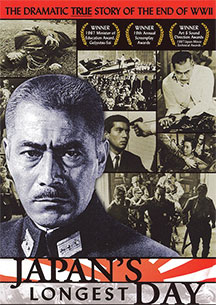
“Much work remained to be done: the Imperial Rescript had to be composed, the Emperor had to record it, and it had to be broadcast to the nation. And there were many soldiers and civilians who could not accept surrender, and would do anything – even commit treason – to avoid it.
“In a single 24-hour period, the fate of 100 million people would be decided. This is the true story of August 15, 1945... (From the text accompanying the film)
Bartlit, a WWII historian who taught in Japan 13 years after the end of the War, will introduce the film, then remain afterwards to answer questions.
COMMUNITY News:
SALA Los Alamos Event Center presented a lecture by Nancy Bartlit Thursday, August 15, 2024, at 6:30 p.m.
The Santa Fe Internment Camp in the Shadow of Los Alamos (1942-1946): Santa Fe’s Mystery History
and Japanese Nuclear Weapons Program During WWII
Event: Nancy R. Bartlit: National Japanese American Citizen's League Conference in Albuquerque, July 17-20. Nancy's talk on Sunday, July 20.
Santa Fe’s Mystery History:
The Santa Fe Internment Camp
in the Shadow of Los Alamos (1942-1946)
Nancy R. Bartlit gathers experiences of New Mexicans and of Japanese during the Pacific War. Through them, she takes us on a journey discovering history by telling both sides of the stories.
“Nancy—historian, educator, author, and publisher—continuously researches from her time as a young teacher living in Japan through a lifetime uncovering and preserving history in Los Alamos and the rest of New Mexico. By her worldwide and American travels to war museums, memorials, and battlefields, she provides untold pieces of the larger World War II history, informing us of New Mexico’s unique contributions. She compares the differences of decision-making in each culture which is often overlooked when explaining the role of the atomic weapons used to convince Imperial Japan to end the War.
Nancy earned a MA in international communication from the University of New Mexico (UNM), having earned a BA degree in history from Smith College. She taught English at a women’s college in Sendai, Japan, 13-15 years after the end of World War II. Later she tutored Japanese exchange scientists working at the national laboratory in her home town Los Alamos. She returned to Japan to study it’s technology and industry before writing her Master’s thesis analyzing the comments written in the Bradbury Science Museum ledger during the summer of the 50th anniversary of the War’s end. The Mesa Public Library houses copies of her work.
A 63-year resident of Los Alamos, she served as Los Alamos’s top elected leader when few women chose to run for public office. While president of the Los Alamos Historical Society, she championed the statues of Dr. J. Robert Oppenheimer and General Leslie R. Groves from conception to dedication in 2011. Meanwhile, she fulfilled a long-term goal of the Society in 2003 to acquire ownership of the Bathtub Row home in which the Oppenheimer family lived during the Manhattan Project years 1943-45.
Bartlit’s book “Silent Voices of World War II,” co-authored with distinguished UNM Professor Everett M. Rogers, Ph.D., spoke for the previously silent heroes of WWII in the Pacific: NM National Guardsmen fated to become POWs for defending an air base in the Philippines; Navajo U.S. Marine privates speaking an unbreakable Navajo code; Japanese immigrants and Japanese American internees assigned to a Santa Fe camp in the shadow of the biggest secret of WWII; scientists and engineers with different specialties and enlisted men and women with scientific training who developed the atomic bombs at Los Alamos, then tested at Trinity.
Their stories, some obtained through interviews with the authors, supplement the historical record, illuminating the patriotism and human suffering of war, revealing courageous humor. Just as Manhattan Project Y’s operation on Tinian Island was necessary for the atomic bombs to be prepared for each mission of the 509th Composite Squadron Bombing Group, so the military success of forward island movement toward Imperial targets intertwined actions needed to win the War. Nancy—historian, educator, author, and publisher—continuously researches from her time as a young teacher living in Japan through a lifetime uncovering and preserving history in Los Alamos and the rest of New Mexico. By her worldwide and American travels to war museums, memorials, and battlefields, she provides untold pieces of the larger World War II history, informing us of New Mexico’s unique contributions. She compares the differences of decision-making in each culture which is often overlooked when explaining the role of the atomic weapons used to convince Imperial Japan to end the War.
Nancy earned a MA in international communication from the University of New Mexico (UNM), having earned a BA degree in history from Smith College. She taught English at a women’s college in Sendai, Japan, 13-15 years after the end of World War II. Later she tutored Japanese exchange scientists working at the national laboratory in her home town Los Alamos. She returned to Japan to study it’s technology and industry before writing her Master’s thesis analyzing the comments written in the Bradbury Science Museum ledger during the summer of the 50th anniversary of the War’s end. The Mesa Public Library houses copies of her work.
A 63-year resident of Los Alamos, she served as Los Alamos’s top elected leader when few women chose to run for public office. While president of the Los Alamos Historical Society, she championed the statues of Dr. J. Robert Oppenheimer and General Leslie R. Groves from conception to dedication in 2011. Meanwhile, she fulfilled a long-term goal of the Society in 2003 to acquire ownership of the Bathtub Row home in which the Oppenheimer family lived during the Manhattan Project years 1943-45.
Bartlit’s book “Silent Voices of World War II,” co-authored with distinguished UNM Professor Everett M. Rogers, Ph.D., spoke for the previously silent heroes of WWII in the Pacific: NM National Guardsmen fated to become POWs for defending an air base in the Philippines; Navajo U.S. Marine privates speaking an unbreakable Navajo code; Japanese immigrants and Japanese American internees assigned to a Santa Fe camp in the shadow of the biggest secret of WWII; scientists and engineers with different specialties and enlisted men and women with scientific training who developed the atomic bombs at Los Alamos, then tested at Trinity.
Their stories, some obtained through interviews with the authors, supplement the historical record, illuminating the patriotism and human suffering of war, revealing courageous humor. Just as Manhattan Project Y’s operation on Tinian Island was necessary for the atomic bombs to be prepared for each mission of the 509th Composite Squadron Bombing Group, so the military success of forward island movement toward Imperial targets intertwined actions needed to win the War.
SALA Los Alamos Event Center presents an important Japanese film to be shown for four Saturdays August 10, 17, 24, and 31, 2024 at 2:00 p.m.
Japan’s Longest Day: Surrender – the Last 24 Hours through Japanese Eyes
“... A dramatization of the 24-hour period in which the Japanese government was deadlocked over the decision to accept or reject the Allies' demand for an unconditional surrender following the bombings of Hiroshima and Nagasaki.”
The End of an Empire! “The dramatic true story of the end of WWII.” This historically based film in Japanese with English subtitles lasts 2 hours, 37 minutes and is in Black & White. It was produced by Japan’s finest cast and crew led by Okamoto Kihachi and Mifune Toshio with other famous Japanese actors. It won a number of awards in 1967 for education, screenplay, and art and sound. The film is based on a Japanese book of the same title, produced by The Pacific War Research Society. Fourteen Society members interviewed eye-witnesses then compiled cross-checked accounts of seventy-nine men who took part in Imperial Japan’s decision to surrender.
“On August 15, 1945, the Japanese people faced utter destruction. Millions of soldiers and civilians were dead, the rest were starving, and their cities had been reduced to piles of rubble – two of them vaporized by atomic bombs. The government was deadlocked; some ministers called for surrender, and others argued that honor demanded a final battle on home soil. To break the impasse, the cabinet took the unprecedented step of asking the Emperor to decide the fate of the nation.
“Unable to bear the suffering of his people any longer, and finally given the power to do something about it, the Emperor decreed that Japan would surrender.

“Much work remained to be done: the Imperial Rescript had to be composed, the Emperor had to record it, and it had to be broadcast to the nation. And there were many soldiers and civilians who could not accept surrender, and would do anything – even commit treason – to avoid it.
“In a single 24-hour period, the fate of 100 million people would be decided. This is the true story of August 15, 1945... (From the text accompanying the film)
Bartlit, a WWII historian who taught in Japan 13 years after the end of the War, will introduce the film, then remain afterwards to answer questions.
COMMUNITY News:
SALA Los Alamos Event Center presented a lecture by Nancy Bartlit Thursday, August 15, 2024, at 6:30 p.m.
The Santa Fe Internment Camp in the Shadow of Los Alamos (1942-1946): Santa Fe’s Mystery History
and Japanese Nuclear Weapons Program During WWII
Nancy will explain what life was like for the 4,555 males of Japanese descent who were interned in the Santa Fe camp during World War II. Learn how the former Civilian Conservation Corps Camp was converted to hold internees whose average age was 52 and had been denied U.S. citizenship even though they had worked in America for two decades or more. Toward the end of the War, many American-born males of Japanese descent were sent to Santa Fe . Innocent of wrong doing against America, they spent their hours under the Geneva-convention rules, governing themselves in 40 barracks under the guidance of the U.S. Department of Justice. How did they pass the hours of waiting for the war to end? Bartlit has collected photos and drawings to illustrate those hours in a popular PowerPoint presentation. The date is the anniversary of Imperial Japan’s announcement of its surrender to end WWII.
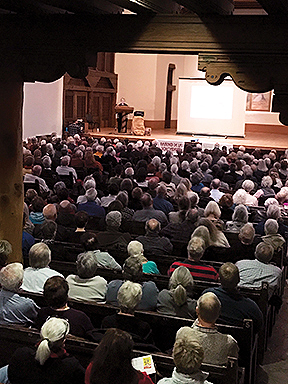
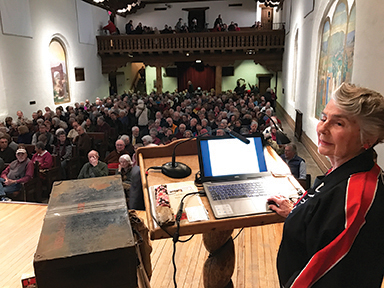
Photos from the balcony
and from the stage: Nancy presenting to a packed house, "The Santa Fe Internment Camp in the Shadow of Los Alamos, 1942-1946," in the St. Francis Auditorium, New Mexico Art Museum on Tuesday, February 28, 2017. For those interested in the Santa Fe Internment Camp history, you would find Robert Mott's interview with Nancy, "South of Atomic City, a second secret community during WWII," as it appeared in the Santa Fe New Mexican, February 27, 2017.


A Packed House!
Nancy lecturing about the SF Internment Camp to a full house
in the New Mexico Museum of Art,
Santa Fe.
Nancy lecturing about the SF Internment Camp to a full house
in the New Mexico Museum of Art,
Santa Fe.
Photos from the balcony
and from the stage: Nancy presenting to a packed house, "The Santa Fe Internment Camp in the Shadow of Los Alamos, 1942-1946," in the St. Francis Auditorium, New Mexico Art Museum on Tuesday, February 28, 2017. For those interested in the Santa Fe Internment Camp history, you would find Robert Mott's interview with Nancy, "South of Atomic City, a second secret community during WWII," as it appeared in the Santa Fe New Mexican, February 27, 2017.
1. Click on the link: Nancy's "Thursday, the 15th Event," below
2. Go to "Events" on the left-end of the menu bar
3. Scroll down to "Parallel Cinema" and select
4. There, you'll see Nancy Bartlit's topic and more information...
Nancy's Thursday, August 15, 2024, Event
On May 14, 2024, The Los Alamos Historical Society sponsored Nancy Bartlit and Dr. John Hopkin's Lectures: Imperial Japan's Conflicted Surrender and Japanese Nuclear Weapons Program during WWII.
Bartlit discussed the complex dynamics within Japan’s military culture during World War II (WWII). Following Bartlit’s lecture, Dr. Hopkins, former Associate Director of the Los Alamos National Laboratory (LANL), provided further insights to Japan’s nuclear program during WWII.
Following Bartlit’s lecture, Dr. Hopkins, former Associate Director of the Los Alamos National Laboratory (LANL), provided further insights to Japan’s nuclear program during WWII.
Bartlit, esteemed WWII historian and author, led an in-depth examination into Japan’s delayed responses to Allied demands for surrender. Her experiences teaching English in Japan and engaging with Japanese culture provide unique insights into their response to historical events like WWII and the dropping of the atomic bomb. Her academic background includes a major in history from Smith College and a Master’s Degree in International Communication from the University of New Mexico. Bartlit’s work extends to co-authoring a book on New Mexico’s contributions to winning WWII and advocating for historic preservation during her time on the Los Alamos County Council.
Dr. John C. Hopkins is a highly respected figure with decades of experience at LANL.
He joined the Los Alamos Scientific Laboratory (LASL) in 1960 to do nuclear physics research in support of the weapons program. He worked in P- and J-Divisions as a test scientist, Test Director, and J-Division Leader before joining the Director’s Office as an Associate Director responsible for the Nuclear Weapons Program (which was about half the lab). Dr. Hopkins has written articles and books about nuclear history and policy issues.
before joining the Director’s Office as an Associate Director responsible for the Nuclear Weapons Program (which was about half the lab). Dr. Hopkins has written articles and books about nuclear history and policy issues.
This lecture was a captivating event for historians, scholars, and anyone looking to gain a deeper understanding of World War II and its impact on global history.
The Los Alamos Historical Society extended a heartfelt appreciation to N3B for their generous sponsorship of the Lecture Series. Their commitment to supporting educational initiatives and preserving history has made a significant impact in our community.
For more information, visit the "Los Alamos Historical Society website."
San Gabriel Historical Society hosted a special Veterans Day event...
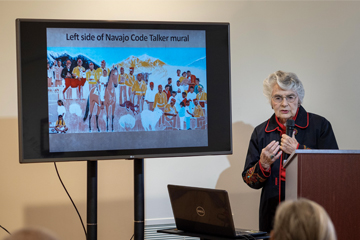
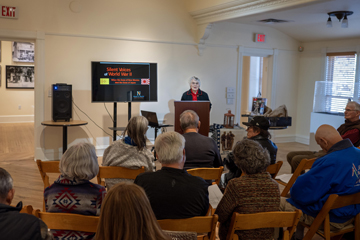 San Gabriel Historical Society was proud to host a special Veterans Day event at the Bond House Museum, Espanola, NM on November 11, 2023, when Nancy R. Bartlit, who is a World War II Historian, author and a member of the New Mexico Historical Society Speakers Bureau, spoke.
San Gabriel Historical Society was proud to host a special Veterans Day event at the Bond House Museum, Espanola, NM on November 11, 2023, when Nancy R. Bartlit, who is a World War II Historian, author and a member of the New Mexico Historical Society Speakers Bureau, spoke.
Her talk Silent Voices of World War II sheds crucial light on the role of New Mexico and its people in ending World War II. It included experiences of the U.S. Army Bataan Death March survivors, the U.S. Marine Navajo Code Talkers, the civilian males of Japanese descent held in the Santa Fe Internment Camp, and the scientists and military personnel assigned to Los Alamos during the Manhattan Project. Pajarito Press LLC. (Photos courtesy of Norman Doggett.)
Contact Nancy R. Bartlit
View a list and summaries of her talk topics
Nancy is available to give talks to your
company, organization, conference, or group.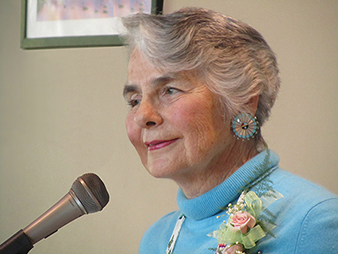
Nancy R. Bartlit is a World War II historian, lecturer, author, and co-owner of Pajarito Press LLC. Bartlit earned a BA in History from Smith College in Massachusetts, then traveled to Sendai, Japan, thirteen years after WWII ended in 1945, to teach English to high school students, UNESCO students, and scientists at a research institute. Years later, she returned to Japan while enrolled in a program on Japanese industry and technology, which included tours to eleven research laboratories. She earned an MA in International Communications from the University of New Mexico.
She arrived in Los Alamos in 1962 when her husband John came to the Los Alamos National Laboratory as a research engineer in cryogenics and, later, fusion energy. The two of them led efforts to preserve New Mexico’s azure skies—which were so important to scientists during the Manhattan Project—and were honored as Los Alamos Living Treasures.
Nancy was elected to several terms on the Los Alamos County Council, was its Chairman, and, later, was elected President of the Los Alamos Historical Society. The Society was founded in 1968 to preserve Los Alamos history through supporting a lecture series, publishing unique books, running a museum, and building community archives.
Her book Silent Voices of World War II, coauthored with University of New Mexico Distinguished Professor Everett M. Rogers, was published in 2005. (It is currently being revised, updated, and re-edited for technical and historical accuracy and published by Pajarito Press LLC.) Since then she has given talks on New Mexico’s role in ending World War II which include experiences of the U.S. Army Bataan Death March survivors, the U.S. Marine Navajo Code Talkers, the civilian males of Japanese descent held in the Santa Fe Internment Camp, and the scientists and miliary personnel assigned to Los Alamos during the Manhattan Project. She is registered with the New Mexico Humanities Council and the Historical Society of New Mexico Speakers’ Bureau.
Bartlit first told Los Alamos history to a symposium held on Tinian Island in 2010. Why was New Mexico selected to be so important to the vital research of atomic weapons? What was life like as a Boys Ranch School in a forest of Ponderosa pine trees expanded into a secret research laboratory where explosive testing in the canyons shook windows and walls to break the silence of the wilderness?
For a decade Bartlit collaborated with the Atomic Heritage Foundation and officials from New Mexico; Oak Ridge, Tennessee; Hanford, Washington, and the National Park Service to promote a Manhattan Project National Historical Park. Los Alamos now shares Park Headquarters with the other two communities. One can witness a virtual viewing of the five historic sites left from war atomic weapons research in Los Alamos in the Laboratory’s Bradbury Science Museum.




2. Go to "Events" on the left-end of the menu bar
3. Scroll down to "Parallel Cinema" and select
4. There, you'll see Nancy Bartlit's topic and more information...
Nancy's Thursday, August 15, 2024, Event
On May 14, 2024, The Los Alamos Historical Society sponsored Nancy Bartlit and Dr. John Hopkin's Lectures: Imperial Japan's Conflicted Surrender and Japanese Nuclear Weapons Program during WWII.
Bartlit discussed the complex dynamics within Japan’s military culture during World War II (WWII).
 Following Bartlit’s lecture, Dr. Hopkins, former Associate Director of the Los Alamos National Laboratory (LANL), provided further insights to Japan’s nuclear program during WWII.
Following Bartlit’s lecture, Dr. Hopkins, former Associate Director of the Los Alamos National Laboratory (LANL), provided further insights to Japan’s nuclear program during WWII. Bartlit, esteemed WWII historian and author, led an in-depth examination into Japan’s delayed responses to Allied demands for surrender. Her experiences teaching English in Japan and engaging with Japanese culture provide unique insights into their response to historical events like WWII and the dropping of the atomic bomb. Her academic background includes a major in history from Smith College and a Master’s Degree in International Communication from the University of New Mexico. Bartlit’s work extends to co-authoring a book on New Mexico’s contributions to winning WWII and advocating for historic preservation during her time on the Los Alamos County Council.
Dr. John C. Hopkins is a highly respected figure with decades of experience at LANL.
He joined the Los Alamos Scientific Laboratory (LASL) in 1960 to do nuclear physics research in support of the weapons program. He worked in P- and J-Divisions as a test scientist, Test Director, and J-Division Leader
 before joining the Director’s Office as an Associate Director responsible for the Nuclear Weapons Program (which was about half the lab). Dr. Hopkins has written articles and books about nuclear history and policy issues.
before joining the Director’s Office as an Associate Director responsible for the Nuclear Weapons Program (which was about half the lab). Dr. Hopkins has written articles and books about nuclear history and policy issues. This lecture was a captivating event for historians, scholars, and anyone looking to gain a deeper understanding of World War II and its impact on global history.
The Los Alamos Historical Society extended a heartfelt appreciation to N3B for their generous sponsorship of the Lecture Series. Their commitment to supporting educational initiatives and preserving history has made a significant impact in our community.
For more information, visit the "Los Alamos Historical Society website."
San Gabriel Historical Society hosted a special Veterans Day event...

 San Gabriel Historical Society was proud to host a special Veterans Day event at the Bond House Museum, Espanola, NM on November 11, 2023, when Nancy R. Bartlit, who is a World War II Historian, author and a member of the New Mexico Historical Society Speakers Bureau, spoke.
San Gabriel Historical Society was proud to host a special Veterans Day event at the Bond House Museum, Espanola, NM on November 11, 2023, when Nancy R. Bartlit, who is a World War II Historian, author and a member of the New Mexico Historical Society Speakers Bureau, spoke.Her talk Silent Voices of World War II sheds crucial light on the role of New Mexico and its people in ending World War II. It included experiences of the U.S. Army Bataan Death March survivors, the U.S. Marine Navajo Code Talkers, the civilian males of Japanese descent held in the Santa Fe Internment Camp, and the scientists and military personnel assigned to Los Alamos during the Manhattan Project. Pajarito Press LLC. (Photos courtesy of Norman Doggett.)
Contact Nancy R. Bartlit
View a list and summaries of her talk topics
Nancy is available to give talks to your
company, organization, conference, or group.

Nancy R. Bartlit is a World War II historian, lecturer, author, and co-owner of Pajarito Press LLC. Bartlit earned a BA in History from Smith College in Massachusetts, then traveled to Sendai, Japan, thirteen years after WWII ended in 1945, to teach English to high school students, UNESCO students, and scientists at a research institute. Years later, she returned to Japan while enrolled in a program on Japanese industry and technology, which included tours to eleven research laboratories. She earned an MA in International Communications from the University of New Mexico.
She arrived in Los Alamos in 1962 when her husband John came to the Los Alamos National Laboratory as a research engineer in cryogenics and, later, fusion energy. The two of them led efforts to preserve New Mexico’s azure skies—which were so important to scientists during the Manhattan Project—and were honored as Los Alamos Living Treasures.
Nancy was elected to several terms on the Los Alamos County Council, was its Chairman, and, later, was elected President of the Los Alamos Historical Society. The Society was founded in 1968 to preserve Los Alamos history through supporting a lecture series, publishing unique books, running a museum, and building community archives.
Her book Silent Voices of World War II, coauthored with University of New Mexico Distinguished Professor Everett M. Rogers, was published in 2005. (It is currently being revised, updated, and re-edited for technical and historical accuracy and published by Pajarito Press LLC.) Since then she has given talks on New Mexico’s role in ending World War II which include experiences of the U.S. Army Bataan Death March survivors, the U.S. Marine Navajo Code Talkers, the civilian males of Japanese descent held in the Santa Fe Internment Camp, and the scientists and miliary personnel assigned to Los Alamos during the Manhattan Project. She is registered with the New Mexico Humanities Council and the Historical Society of New Mexico Speakers’ Bureau.
Bartlit first told Los Alamos history to a symposium held on Tinian Island in 2010. Why was New Mexico selected to be so important to the vital research of atomic weapons? What was life like as a Boys Ranch School in a forest of Ponderosa pine trees expanded into a secret research laboratory where explosive testing in the canyons shook windows and walls to break the silence of the wilderness?
For a decade Bartlit collaborated with the Atomic Heritage Foundation and officials from New Mexico; Oak Ridge, Tennessee; Hanford, Washington, and the National Park Service to promote a Manhattan Project National Historical Park. Los Alamos now shares Park Headquarters with the other two communities. One can witness a virtual viewing of the five historic sites left from war atomic weapons research in Los Alamos in the Laboratory’s Bradbury Science Museum.
A Look Back...
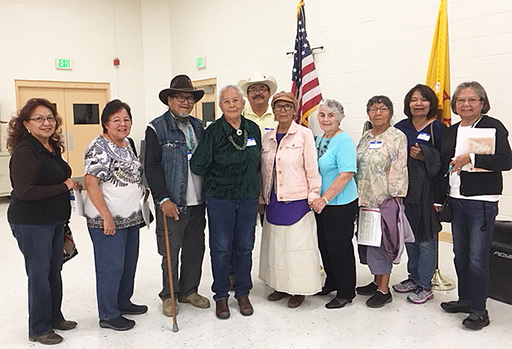 From 1942 until the end of
From 1942 until the end of
World War II the Navajo code was never broken by the enemy. Between 350–420 young Navajo U.S. Marines, trained in a unique language, fought from Guadalcanal through Okinawa, a territory of Japan. Their military commander claimed that they shortened the war by a year. She'll describe how the code was initiated by the original 29 Navajo U.S. Marine radiomen who had deep knowledge of Navajo culture and environment, how the number of code talkers expanded to serve in six Marine divisions forcing increased vocabulary as new technology was introduced on the battlefield, and how the "code-within-a-code" protected its secrecy. With precise accuracy the code was put to use in the Pacific theater allowing the allied forces to island hop and get closer to target Japan.
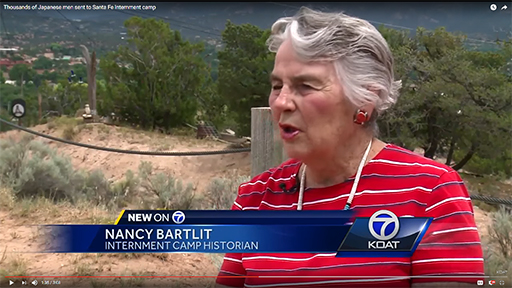 Watch the interview with Nancy
Watch the interview with Nancy
on KOAT TV, July 24, 2017.


Photos: Nancy presenting to a packed house, "The Santa Fe Internment Camp in the Shadow of Los Alamos, 1942-1946," in the St. Francis Auditorium, New Mexico Art Museum on Tuesday, February 28, 2017. For those interested in the Santa Fe Internment Camp history, you would find Robert Mott's interview with Nancy, "South of Atomic City, a second secret community during WWII," as it appeared in the Santa Fe New Mexican, February 27, 2017.
The New Mexican—Posted: Tuesday, July 14, 2015, 11:00 pm | Updated: 9:14 am, Tuesday, July 28, 2015.
In the article, New Mexico, Japan Bound by Technology and Tragedy, Nancy is interviewed by Margaret Wright, who gives you the opportunity to read Nancy's comments and gather the history that was built in the Pacific Theater during WWII. Here are two links where you can read about and also listen to Nancy's position on the atomic bombs:
Read Margaret Wright's article and see the short video: Trinity: 70 Years Later...
Read Nancy's Perspective: Nancy's View—Were Two Bombs Necessary?
A Warm and Enthusiastic Welcome as Nancy Spoke to the San Juan County
Historical Society on October 11, 2017, in Aztec, New Mexico...
Historical Society on October 11, 2017, in Aztec, New Mexico...
 From 1942 until the end of
From 1942 until the end of World War II the Navajo code was never broken by the enemy. Between 350–420 young Navajo U.S. Marines, trained in a unique language, fought from Guadalcanal through Okinawa, a territory of Japan. Their military commander claimed that they shortened the war by a year. She'll describe how the code was initiated by the original 29 Navajo U.S. Marine radiomen who had deep knowledge of Navajo culture and environment, how the number of code talkers expanded to serve in six Marine divisions forcing increased vocabulary as new technology was introduced on the battlefield, and how the "code-within-a-code" protected its secrecy. With precise accuracy the code was put to use in the Pacific theater allowing the allied forces to island hop and get closer to target Japan.
KOAT TV's Royale Da Interviews Nancy about Santa Fe's Internment Camp...
 Watch the interview with Nancy
Watch the interview with Nancy on KOAT TV, July 24, 2017.


A Packed House!
Nancy Delivers the Powerful, Seldom-Heard but Not Forgotten History of Santa Fe's Internment Camp...
Nancy Delivers the Powerful, Seldom-Heard but Not Forgotten History of Santa Fe's Internment Camp...
Photos: Nancy presenting to a packed house, "The Santa Fe Internment Camp in the Shadow of Los Alamos, 1942-1946," in the St. Francis Auditorium, New Mexico Art Museum on Tuesday, February 28, 2017. For those interested in the Santa Fe Internment Camp history, you would find Robert Mott's interview with Nancy, "South of Atomic City, a second secret community during WWII," as it appeared in the Santa Fe New Mexican, February 27, 2017.
The New Mexican—Posted: Tuesday, July 14, 2015, 11:00 pm | Updated: 9:14 am, Tuesday, July 28, 2015.
In the article, New Mexico, Japan Bound by Technology and Tragedy, Nancy is interviewed by Margaret Wright, who gives you the opportunity to read Nancy's comments and gather the history that was built in the Pacific Theater during WWII. Here are two links where you can read about and also listen to Nancy's position on the atomic bombs:
Read Margaret Wright's article and see the short video: Trinity: 70 Years Later...
Read Nancy's Perspective: Nancy's View—Were Two Bombs Necessary?
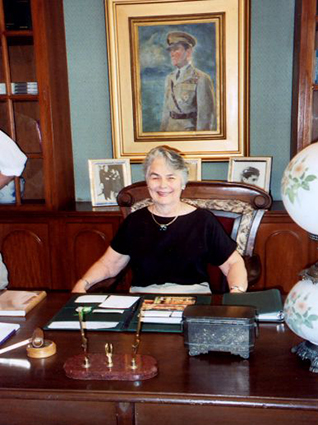
|
|

|
|
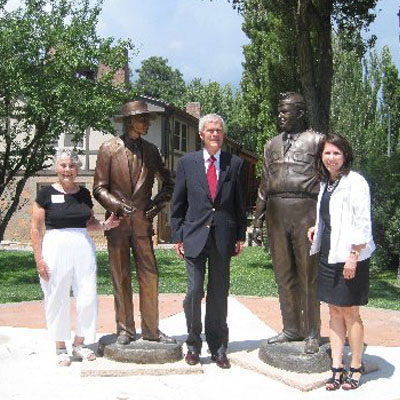
|
|
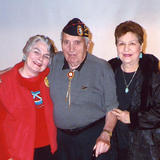
|
|
Photos clockwise • Nancy sitting in MacArthur's chair in Hotel Manilla in the Philippine Islands.
• Nancy with U.S. Senator Jeff Bingaman and Sharon Stover, former Los Alamos County Chair with "Oppie" and Groves bronze sculptures. Bingaman and U.S. Senator Tom Udall, introduced legislation that resulted in the creation of the Manhattan Project National Historical Park, which is inclusive of the three cities instrumental in atomic research and development: Los Alamos, NM, Oakridge, TN, and Hanford, WA. • Nancy with Vincente & Celia Ojinaga at the Santa Fe Library in 2006. • Nancy presenting one of her seminars for the Los Alamos Historical Society docents and tour guide trainees in June, 2015.
• Nancy with U.S. Senator Jeff Bingaman and Sharon Stover, former Los Alamos County Chair with "Oppie" and Groves bronze sculptures. Bingaman and U.S. Senator Tom Udall, introduced legislation that resulted in the creation of the Manhattan Project National Historical Park, which is inclusive of the three cities instrumental in atomic research and development: Los Alamos, NM, Oakridge, TN, and Hanford, WA. • Nancy with Vincente & Celia Ojinaga at the Santa Fe Library in 2006. • Nancy presenting one of her seminars for the Los Alamos Historical Society docents and tour guide trainees in June, 2015.